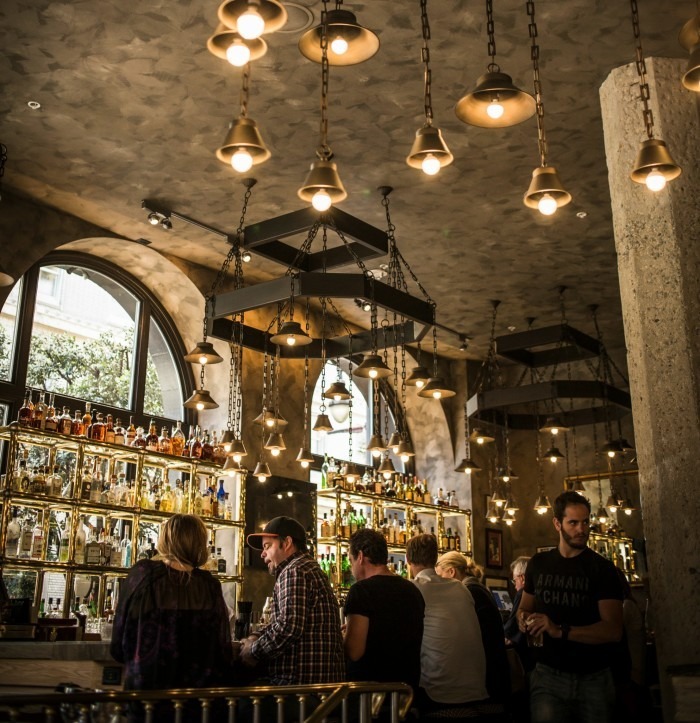Japanese Whisky Is Here To Stay, And Scotland Is Paying Attention
In June, Food Republic is counting the many reasons to love Asian food in America right now. Here's one of them.
Back in the 1980s, Shawn Thompson, general manager of the Chicago bar Twisted Spoke, lived in Japan. "I used to go to clubs where after you paid a cover they'd give you a Suntory bottle shaped like blended Pinch scotch," he remembers. At the time, skepticism that the Japanese could produce quality blended and single malt whiskies was high, and it was more common to reinforce the image of "superior" scotch instead. But boy have times changed.
When Shinjiro Torii established Japan's first single malt whisky distillery in 1923 — now known for producing such lauded brands as Yamazaki, Hibiki and Hakushu — scotch, a luxurious symbol of Western culture, was undoubtedly the inspiration. Likewise, sake scion Masataka Taketsuru headed to Glasgow in 1918 to learn the art of making whisky, which resulted in him introducing the beloved Nikka in 1934. The Scottish influence is clear. Japanese whisky is spawned from malted barley and made in pot stills just like its European muse, but the character is distinctly Japanese — elegant and balanced.
"What I like about these whiskies is that they are all well made and taste like Scotch single malts," says Thompson. "They don't take shortcuts like many American ones. They are driven to perfect the single malt."
Because so little of the liquid was exported until recent years, Japanese whisky was long a mystery outside of its homeland, while within Japan, in the wake of rising interest in wine and other spirits, domestic sales of whisky have declined sharply since the 1980s. Selling more of its whisky overseas has proven a successful alternative for producers, although according to Nielsen, Japanese whiskies only doubled sales versus the prior year on a relatively small base. "It's likely that they will continue to grow at substantial levels given the growing interest of the American consumer in whisky generally, as well as the support it will likely get from some larger companies in the U.S. with a Japanese whisky portfolio," says Danny Brager, Nielsen's senior vice president for beverage alcohol practice.
This rising interest in brown spirits has also led to people sipping on top-notch whisky from such unlikely countries as Taiwan and India. It was the perfect time for thoughtfully crafted Japanese whisky, lush and rife with floral notes, to make an impact globally. That the 2013 Yamazaki Single Malt Sherry Cask was deemed the world's best whisky by Jim Murray's Whisky Bible 2015 further cemented the spirit's fine reputation. Finally, it was no longer wrongly considered a scotch impostor once the world heard a forlorn Bill Murray saying, "For relaxing times, make it Suntory time" in the hit 2003 flick Lost in Translation.
Daniel Grajewski, beverage director for the Mina Group, sees a marked increase in interest in Japanese whisky, particularly at Pabu Izakaya, which opened in San Francisco last year. "Where the U.S. once only received a dozen or so imports, this number has almost tripled; there are so many options of great quality," he says. "It has been one of the best-performing areas of our beverage list."

Japanese restaurants aren't the only establishments where interest is high. Saxon + Parole in New York has long been a champion of Japanese whisky. Masa Urushido, who presides over the bar, says the Japanese make better and better single malts every year. "Whenever I pull out a bottle, guests are curious," he says.
Although Japanese whisky is gaining considerable traction, for a number of patrons there is still an element of mystery that clings to the spirit. "I think people are excited to see something new compete with something old and actually hold its ground. For years scotch has been the king, and people are enjoying the opportunity to try its younger competitor," Grajewski explains.
Kevin Diedrich, bar manager of the recently opened BDK Restaurant & Bar in San Francisco, says while some guests confidently ask for, say, Nikka Coffey Grain or Hibiki 12-year-old specifically, many remain baffled. "Is it scotch? Bourbon? What is it?" they ask.
Typically, Japanese whisky is savored neat or over a large sphere of ice, much like its Scottish, Irish and American siblings. "When requested with a rock, we like to serve it in a Bordeaux wineglass to really capture the beautiful aromatics that Japanese whisky exemplifies," Grajewski says. Urushido is a fan of serving Japanese whisky in highball form. "It's a classic style: just good whisky and quality ice and soda water. In the spring and summer we make it with Hakushu because it has a more green profile; in the fall we use Yamazaki because of its spice," he explains.
The spirit's versatility, Diedrich notes, also translates well to cocktails, "which allows bartenders to use it in simple drinks, like an old-fashioned or even a whisky sour, to help guests become more familiar." He also makes more ambitious concoctions, like the Ardbeg scotch-laced Smoke, which stars Nikka Coffey Grain and melds Kalani Coconut Liqueur, fresh lemon juice and Angostura bitters. At Pabu Izakaya, customers spring for Japanese whisky cocktails such as the Yakuza with Nikka Coffey Grain, Crème de Violette and Siberian rose tea, as well as the Classic Lolita, which marries Nikka Pure Malt, Okinawa sugar, and orange and old-fashioned bitters for a finessed spin on the old-fashioned.
Twisted Spoke may be a low-key biker bar, but the fact that Japanese whisky is relished there reveals just how far-reaching the spirit has become in a short amount of time. Thompson believes its future is a bright, ascendant one. "Some people are lemmings and follow trends. The more this trend builds, the more will jump on board. Those who just like a good whisky are already there," he assures. If he were to pay visits now to those Japanese nightclubs of yore, surely the word "scotch" would never be uttered.

